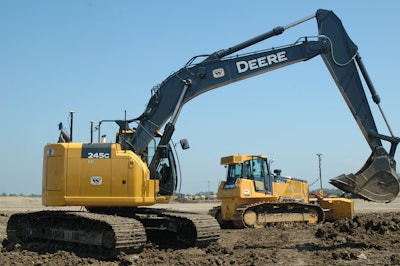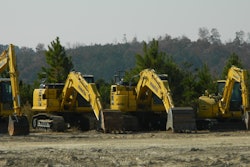
While the global economy remains firmly on track to expand in 2022, a number of challenges could become obstacles for the construction equipment industry in the weeks and months ahead.
According to the latest business intelligence data assembled for Association of Equipment Manufacturers (AEM) members, the global economy expanded by a robust 5.1% in 2021. And while projected growth of about 3.9% is expected for 2022, slower growth seems like a foregone conclusion. Short-term factors like the lingering COVID-19 pandemic, ongoing supply chain issues and persistent labor shortages, as well as long-term factors like deglobalization and inflation, have emerged to dampen enthusiasm a bit on the heels of what has been a strong economic resurgence worldwide.
“The last recession we experienced ended the longest period of economic expansion in the United States, and that recession lasted from February 2020 to April 2020,” said Benjamin Duyck, AEM director of market intelligence. “Two months, in traditional economic terms, can’t even be accurately described as a recession. However, this economic disruption has impacted us all greatly, and we are still dealing with the aftereffects today – labor shortages, supply chain problems and higher interest rates.”
Continued Growth on the Horizon
The question of when the next economic recession will hit is one that’s easily asked, but not so easily answered. Recent volatility in the stock market has done little to quell concerns. However, the stock market is still up 20% when compared to a year ago, and 30% from two years ago (just prior to the onset of the COVID-19 pandemic).
“Can we accurately predict the next recession?” asked Duyck. “No, and it’s a common joke that economists predicted 15 of the last 10 recessions. In other words, they are frequently wrong and pessimistic. Though, it will be interesting to see what happens, especially with high inflation.”
AEM has surveyed its members quarterly for nearly two years regarding how quickly they expect to recover to pre-COVID-19 levels. For some time, the responses had been generally quite positive, according to Duyck.
“But the data for this last quarter is moving again in the other direction, largely due to the headwinds we’re facing with inflation, workforce issues and supply chain disruptions,” he said.
Mitigating Factors
When it comes to construction equipment, the impact of inflation has been rising gradually, with a 9.7% increase in the last quarter. Talent acquisition is also a significant – and troublesome – factor for manufacturers. According to the results of AEM’s most recent quarterly member survey, hiring on the manufacturing floor remains a major issue – 84% of all respondents have experienced issues in this area.
Respondents offered a wide range of potential strategies and tactics for addressing hiring challenges, but it’s clear workforce will remain a prevalent issue for equipment manufacturers for the foreseeable future.
What’s also clear are the factors that have led to the supply chain problems currently plaguing construction equipment manufacturers, according to Duyck. “COVID-19, followed by growing numbers of employees leaving the workforce, have led to both shutdowns and scarcity of products,” he stated.
As a result, and in response, the supply chain has intended to initially adjust production lower, expecting lower demand. In addition, shipping companies cut schedules, expecting a drop in demand for shipments. And while demand in some aspects of the economy dropped, the decrease was not evenly spread over all industries and all workers.
AEM Member Perspectives
According to AEM’s most recent quarterly survey of its members, more than 95% of both ag and construction equipment manufacturers that responded said they are experiencing supply chain issues. However, it appears either demand is beginning to normalize, or supply chain signaling is improving, because 44% of respondents noted the issues are beginning to turn around.

However, despite all the challenges impacting the ag and construction equipment industries, growth is still expected (albeit at a slower rate than in recent months).
Market Outlook
For the construction equipment market:
- Construction industry value is expected to grow 4.5% this year, largely driven by residential.
- AEM member perceptions show strong demand (83% see year-over-year growth ahead), and it’s reasonable to expect growth of 6% to 10% over the next 12 months on the heels of 6% to 10% stronger growth than was expected in 2021.
- Infrastructure spending is set to gain significant momentum in the coming years.
- Uncertainty related to the COVID-19 pandemic, high material costs and monetary policy all remain concerns.
“Ultimately, the imbalance between supply and demand and COVID-19 restrictions eliminated all the inventory and the grease that allows the global supply clock to operate,” said Duyck. “Another metaphor that maybe hits closer to our industries is this: We’re running a machine that’s low on oil, and almost out of it. The machine will continue to run, and maybe even run for a while – until it doesn’t.”

















